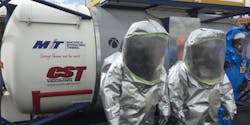Tank Service Inc, CST partner on hazmat safety training for Panama port
Tank Service Inc, a specialist in quality high end repair and modification of new and used portable ISO tanks, was recently presented with one of its more unusual requests--to restore a second-hand ISO tank container that would train emergency responders at one of the world’s largest, most dangerous container ports.
SSA Marine is one of the world’s largest privately held marine and rail terminal operators in the world. After a tank container carrying yellow phosphorous caught fire in 1995 and no one locally could contain the mishap, operators at SSA’s Manzanillo International Terminal (MIT) near Colon, Panama realized that they would need a dedicated hazmat team on-site at every port to keep their employees and customers safe.
MIT reached out to Brian Heinz, founder of Chemical Safety Training (CST), who specializes in nationally accredited instruction in hazardous material handling and emergency response procedures. After spending several years as an emergency management instructor at the California Specialized Training Institute (CSTI) and as a volunteer firefighter, Heinz realized that there was a world of opportunity, and that he needed to find the best way to bring the classroom to the students.
Knowing that he needed a hands-on training device that simulated real life emergency hazmat scenarios in a container handling port, Heinz recently set out to find a way to incorporate virtually every tank container feature available, all in one condensed training aid.
His search brought him to Houston TX-based Tank Service Inc. (TSI). After the first discussion, Russell Harrison, owner of TSI, knew that he wanted to be a part of this unique and important project. “This was an endeavor that we knew was really going to save lives,” said Harrison. “We were excited to jump on board and help with the initial planning of valve locations, sizes, gauges, etc. and lend our expertise to this important training initiative.”
Heinz worked with Tank Service to modify a standard 24,000 liter ISO tank container within a 20’x 8’x 8.6’ ISO frame, to demonstrate both liquid and gas types of chemical transport. The tank gives participants an introduction to the two main types of ISO tanks that are used globally and the main culprits for bulk chemical hazards. One side of the tank represents a low-pressure liquid tank, also known as a T11 tank, while the other simulates a high pressure liquefied gas tank, also known as a T50 gas tank.
The liquid side of the tank includes all of the standard valves, as well as a dip tube with a sump to demonstrate top-only discharge functionality and a custom fabricated leak detection wall. The gas side also includes typical valves for gas transport--PRV, liquid, and gas valves, and a level gauge, as well as internal piping that is commonly found on gas tanks.
The tank is equipped with an interior access door allowing trainees to get a walk-in view of all of the external tank attachments from inside. It also features TSI’s unique bolt-On safety equipment, including full walkway coverage, safety handrails and a safety ladder to access the top of the tank, which can easily be removed during a simulated emergency exercise.
The first mission for MIT’s training tank was to provide hands-on training to port workers from various South American countries as part of its 160-hour Hazardous Materials Technician program in Panama in May 2016 and most recently in October 2016.
Trainees there were introduced to various real-world scenarios of common problems on ISO tanks and how to correct them, as well as International Maritime Dangerous Goods (IMDG) emergency response training tactics. Everything from what to do if a valve is leaking to how to handle an explosive device on a tank are addressed in MIT’s hazmat program, conducted on-site by Heinz and Dean Faina of SSA.
“The more emergency responders can become familiar with these tank types; their markings, specifications, common fittings, and how they are designed to function under normal operating conditions, the better they will be prepared to deal with them during real-life emergency situations,” said Heinz.
Heike Clausen, current president of the International Tank Container Organization (ITCO), said that safety procedures regarding ISO tank handling are of the utmost importance for the industry. "The fact that the global tank container fleet has continued to grow for decades certainly reflects the accepted recognition of the tank container as a safe, reliable, economic and sustainable means of transport," said Clausen. “However, "in an industry dealing with transport and hazardous materials, success is strongly linked with health protection, safety, quality of service and material as well as minimizing environmental impact."
ITCO encourages its members to contribute to industry audits and certifications--such as SQAS (Safety and Quality Assessment), CDI-mpc and DIN ISO 9000ff as ways of keeping current with safety standards. It also promotes safe handling procedures through a variety of guidelines, workgroups, and presentations throughout the year.
“We’re excited that we could play a part in customizing this unique training aid," said Harrison. “As our industry continues to grow and mature, it’s vital the experiences of people like Mr Heinz are passed on to new constituents working on and with tank containers. Everyone has a vested interest in safety. Working with our customers to customize equipment and identify safer ways of handling tank containers is what we do best.”
